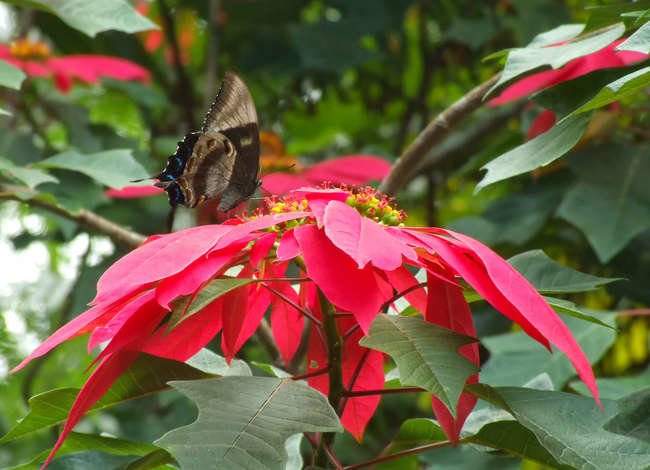

We may earn revenue from the products available on this page and participate in affiliate programs. Learn More ›
Home Advice You Can Trust
Tips, tricks & ideas for a better home and yard, delivered to your inbox daily.
Fern

Ferns have been living and thriving since before the dinosaurs walked the earth. If you’ve ever taken a hike through the woods, you’ve no doubt seen them spreading gracefully alongside the trail. There are thousands of fern varieties growing in all types of environments, from moist and shady forest floors to dry, desert rock faces. Many species do well as easy-to-care-for houseplants, which makes them a popular choice for designers and homeowners alike.
Philodendron

flickr.com via Leonora (Ellie) Enking
Philodendron is among the most popular houseplants because it is extremely tolerant and durable in a variety of environments. Its “roots,” however, lie in the tropical jungles of the Americas and West Indies, where its leaves can grow incredibly large. While philodendron will tolerate low light as a houseplant, it prefers medium light, and it loves humidity. Regularly spritz the leaves with water, and the plant will grow lush, shiny foliage.
Pothos

Native to India, China, Japan, Australia, and Indonesia, pothos grows well as a houseplant if it’s given the right care. Pothos is a vining plant with marbleized leaves, which are its chief beauty. In the wild, it attaches itself to trees and branches through aerial roots. In the home, however, it will happily live in cactus potting mix. You’ll know it has outgrown its pot when it sends those aerial roots out in search of more soil. Keep the plant in partial shade, and water it when the top inch of soil has become dry.
Orchid

Wild orchids are most commonly found in rainforest environments, where they don’t typically grow in the ground, but rather attach themselves to the roots and bark of trees. An orchid in the home also requires a loosely packed medium, such as bark chips or stones, so its roots can get the oxygen the plant needs to keep healthy. While orchids are often described as fussy and difficult to grow, there are many rugged varieties that make excellent houseplants. Once you buy or receive one, you may get hopelessly hooked on their gracefully slender stems and elegant blooms.
Begonia

flickr.com via Eric Hunt
Begonia has long been a favored houseplant, with some varieties boasting spectacular foliage, and others, showy blooms. They are native to Asia, South Africa, and Central and South America, and more than 1,000 varieties grow in the wild. Whatever variety of begonia you choose to bring home, give it plenty of indirect light and mist the leaves daily during dry winters, as it needs humidity to flourish.
Snake Plant

Snake plant, also known as mother-in-law’s tongue, is native to West and Southern Africa but can be found living in wild conditions in both Florida and Hawaii. It is one of the easiest houseplants to keep alive, as it can sustain a lot of neglect and abuse, tolerating low light and drought alike. Their architectural shape and pert, sword-shaped leaves, make them a welcome addition to any home or office with a modern flair.
Kalanchoe

flickr.com via Martin Heigan
Kalanchoe is a low-maintenance flowering succulent and a staple of the holiday florist trade, along with the poinsettia and the Christmas cactus. Originating in Africa, Southeast Asia, and China, the plant will brighten any winter windowsill with colors from bright oranges and yellows to pinks, reds, and even white. If you receive a kalanchoe during the holiday season, place it in a sunny window and water it sparingly. It will reward you with cheerful blooms through a cold and dreary winter.
Poinsettia

Everyone knows the cheerful, red poinsettia, which shows up in churches and homes during the holidays. In actuality, the poinsettia is a small tropical tree that can reach a height of up to 12 feet in the wild. Native to southern Mexico, it was used by the Aztecs to dye fabric and control fevers. You can keep your poinsettia happy by placing it near a sunny window without drafts and watering it thoroughly when the surface soil is dry to the touch.
Bromeliad

There are more than 2,800 species of bromeliad, many of which can be found growing in the wild in Central and South America. Belgian traders began the domestication of the bromeliad when they brought a variety of plants back to Europe in the 1700s. There are so many varieties of bromeliad available, in every color, that you should easily be able to find one that suits your taste.
Monstera

The common houseplant monstera is also known as Swiss cheese plant because of its large, perforated leaves. In its native habitat in the tropical rainforests of southern Mexico, it is capable of growing between 60 and 70 feet tall. As a houseplant, however, it remains much smaller and is relatively easy to care for. It can still reach up to 10 feet tall indoors, making it a lovely, dramatic addition to an atrium or grand foyer.

All You Need to Care for Your Lawn & Garden
Keeping your grass green and your plants thriving doesn’t just take a green thumb—it starts with the right tools and supplies.